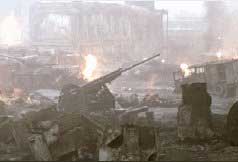
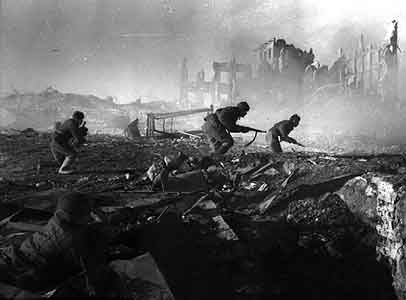
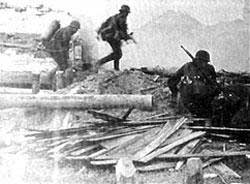
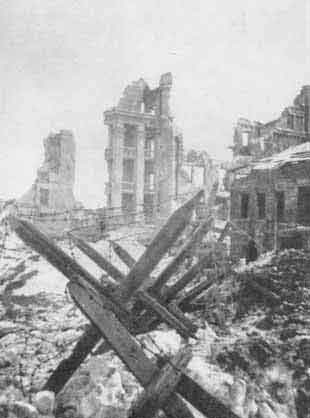
Bloody city... Stalingrad
The battle that lasted from June, 28 1942 - February, 2 1943 turned out to be the bloodiest battle of the II world war, and for so many the final resting place.




After failing to take Moscow, and Rostov in the winter of 1941/1942 the German Army didn't have the immense power it previously had, and could not continue attacks throughout the 3000 km long Eastern front line. Hitler decided to reinforce the German positions throughout the front, and to take a massive offensive through Ukraine in the Spring of 1942 using the Army group South. Army Group South was divided in 2 groups: South Army group A, under command of Erich von Manstein, and Paul von Kleist, and South Army group B, under command of Friedrich Paulus consisted of his 6th Army, and Hermann Hoth's 4th Panzer Army. Army group A was given the task of pushing through the Russian steppes toward the Caucasus region to the Caucasus mountains, the city of Grozny, and to the city of Astrakhan located on the coast of the Caspian lake. Army group B had the task of pushing through to Stalingrad, and at the end capturing the city, and the region all the way to Volga river. This huge military offensive was called "Operation Blue". German Army started massing up in the southern region of the front. The region that was about to be attacked was of strategic importance to both sides, as huge mineral, and oil reserves laid there. If the Germans could capture those oil fields it would mean weakening the Soviet troops for a long time, as much of those oil reserves were used for the purposes of their own army. On the other side the Germans would benefit not only from weakening the Soviet army, but they too could use the oil for their own army, in order to conclude a long, and total war. Also the capture of Stalingrad was of great importance to the Germans, as it was a major industrial city, located on the river Volga, which was an important transport route between the Caspian sea, and the northern parts of Russia. Also it held an ideological, importance to Hitler as the city bore the name of his arch enemy Joseph Stalin, and the fall of Stalingrad would have a great propaganda importance for Hitler. As it turns out Stalin came to the same conclusion. The Soviet command had discovered the massive build up of German troops on the line of Kharkov, Bjelograd, Kursk (the southern part of the eastern front), and as a result they launched an attack on the 12th of May 1942 pushing 60 km deep into the enemy territory, postponing the German offensive for a month. Unfortunately Stalin refused to send reinforcements to the southern area of the front fearing that the Germans could strike at Moscow, leaving his own southern troops vulnerable to attack. Unfortunately as a result of that strategic mistake later on German army took key cities such as Rostov and other in the Crimean area. The Axis powers now consisting of some 250,000 troops from Germany and some 250,000 troops from their allied countries, Hungary, Romania and Italy were ready to pour into the outskirts of Stalingrad. The German Army Group B moved across the Don River taking positions north of the city. German allied countries had the task of sending their troops to the flanks north and south of the city therefore protecting both sides of the German army from a possible counterattack. The Germans left the task of pushing into Stalingrad to them selves, wanting to resolve the battle as quickly as possible. On June, 28 1942 the bloodiest battle of the second world war had begun, leaving devastating consequences for both sides, and many families without their loved ones... As nazi forces quickly advanced into the outskirts of Stalingrad, relying on their well proven Blitzkrieg tactics, the Soviet resistance was slowly collapsing, and weakening on the Southern part of the Eastern front. The German 6th Army, commanded by Field Marshal Friedrich Paulus broke through the Soviet defense lines and began to enter the city from the west. The tactics of the Germans were relying on the well known Blitzkrieg tactics with a key element of surprise attack, quick advance, and decisive victory. Italian, Hungarian, and Romanian forces secured positions on the flanks of the German army to the north and south of the city. As the situation grew more seriously Stalin, realized the importance of the situation, and in June 1942 he moved the 64th, and newly formed 62nd Army under command of Vasily Chuikov just 8 miles of Stalingrad, ordering them to defend the city at all cost therefore reinforcing the city. With the help of Soviet river navy the evacuation of the city soon began. Soviet forces were able to hold off the German advance for the time being. The bloodiest, and deadliest battle of the II world war had begun...
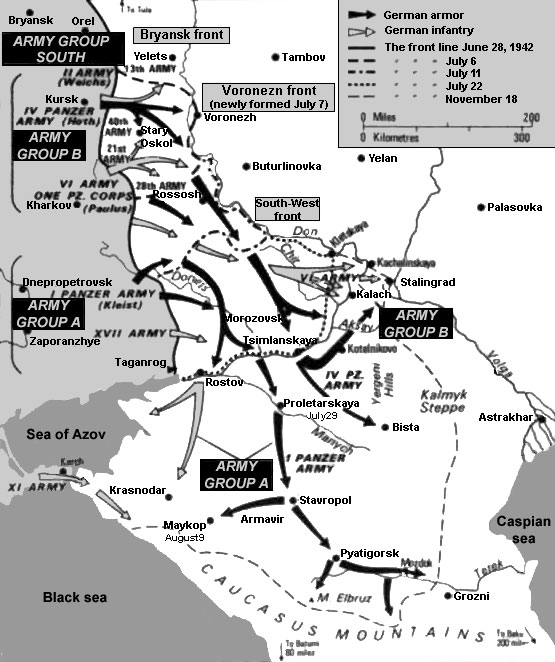
On August 19, Friedrich Paulus commander of the German 6th army mounted the first assault on Stalingrad, with the support of the 4th Panzer army. The attack proved disastrous for the Red Army. By August 23, German forces had reached the Volga River north of Stalingrad. The Romanian 3rd army was given the task of securing the area to the river Don instead of German 11th, and 17th corpuses. Stalingrad was bombarded day and night non-stop by the German air force, making Stalingrad an inferno. On the 25th of August a state of emergency was declared by the city authorities. After reaching the city its self on 12th of September 1942 the 6th German army was given the task of invading the city, and the 4th army was given the task of securing positions to the south of Stalingrad. Around 100,000 people were evacuated, and in a short time after that some 300,000 civilians were evacuated to safety. Soviet river navy had a crucial role in saving lives of the citizens of Stalingrad, and later in defending the city. The 6th German army under command of Field Marshal Friedrich Paulus was consisted of some 13-14 divisions. The ground attack was supported by 4 fleets of Luftvafe in the total amount of some 1000 planes. September, 13 1942 marked the attack on the city its self. Stalingrad's citizens that have decided to stay in the city and defend it with all they could, and by all means possible, and that were not evacuated, organized them selves in groups of 50 - 100 people, and have taken all stronger buildings in the city. The citizens of Stalingrad worked together with the army in small combat units inflicting heavy casualties on the nazi invading troops. The city was turned into a living hell, and streets were covered with destroyed buildings, and bodies, and body parts. Stalin was growing very weary about the situation, he ordered Marshall Zhukov to command Soviet forces at the Southern front. He worked frantically to stabilize German assaults on the beleaguered city. Throughout the months of September and October, Bitter fighting raged in Stalingrad. The fighting was now street by street and house by house. The Soviet Red Army fought and died for every inch of the city. As a result, the fiercest fighting of the war was taken place. Men and women of Stalingrad often found them selves in situations where they were fighting the enemy at distances of only half a meter to a meter and a half... The 62nd Army, commanded by General Vasily Ivanovich Chuikov was holding on by a thin thread, and were now loosely holding only one eight of the city. The Germans had taken 80% of the city and were pushing the Red Army to the Volga River. Nevertheless, the 62nd Army held the German advance in Stalingrad, with the huge help of the Soviet river navy, who fought heroically to save the city. During this time, Marshall Zhukov and General Vasilevsky devised a brilliant plan called Operation Uranus. They saw that German flanks were protected by weak Axis powers, which the Red Army could over power. The Red Army secretly began to mobilize one million troops, 14,000 heavy guns, 979 tanks, and 1,350 aircraft to attack German flanks. US army sent reinforcements of airplanes, guns and ammunition to the Soviet army, realizing the importance of the situation on the eastern front. On November 19, Soviet forces from the Southwestern Front and Don Front attacked Romanian, Italian , and Hungarian positions. Axis armies soon found them selves in a rain of artillery shells launched in tight formations by the Soviet army. The front collapsed as fast moving soviet troops began encircling German Army Group B from the North and South. This created a panic among the German soldiers, trying frantically to get out of the encirclement. Within four days, the two Soviet armies met 60 miles west of Stalingrad. The German 6th infantry and 4th panzer armies were completely surrounded, a total of 330,000 men. The Armies tried to break out but failed. Although the Germans had the far more superior tiger tanks, the Soviet army had the far more simple T-34 tank, which was easier to produce, and was available in much larger quantities than the heavily armored, and far more sophisticated tiger tanks of the 4th German panzer army. Even though in average one German tank destroyed four Soviet tanks, that still wasn't enough, and they simply couldn't cope with the numerical tank superiority of the Soviet armored divisions. Now the supply routs were cut off the Germans trapped in Stalingrad. The only alternative was to have supplies airlifted from German held territory into Stalingrad. Soviet air defense managed to shoot down a huge number of enemy airplanes cutting off most of German supplies. In the months of December 1942 and January 1943, the German 6th Army fought a desperate contest against Soviet forces. Hitler ordered that the German Armies may not surrender, they must fight to the bitter end. German propaganda made sure that the German population doesn't find out of the failure of their army's attempt to take the city of Stalingrad, and on the Christmas eve they broadcasted a radio show where actors acted like the German soldiers were having a lot of fun, they were singing, and making jokes, like the victorious end was close, where in fact the reality was totally different... that night was one of the bloodiest nights for the German army in Stalingrad. Most of the soldiers followed Hitler's orders and fought fanatically to the death. Finally, with no food and supplies, faced with bitter Russian cold, and low on morale the situation for the Germans looked bleak. The Army was on the verge of starvation. Field Marshall Paulus had no choice but to surrender what was left of the 6th Army and 4th Panzer Army. The Casualties in the battle of Stalingrad were catastrophic for both sides. Of some 1.000.000 citizens of Stalingrad, only around 30.000 of them survived. All buildings were destroyed except 3 houses. The Germans lost 147,000 men and 91,000 were taken prisoner. The Red Army paid a huge price for victory, some half million men were killed in the battle. The battle of Stalingrad showed to the world that the mighty German war machine was vulnerable. It gave overwhelming confidence and strength to the Red Army. Also, the battle became the turning point on the Eastern Front, and in the Second world war, changing the history for ever. The Red Army began to slowly push the invaders out of the Soviet Union.
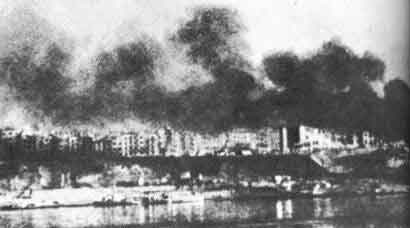
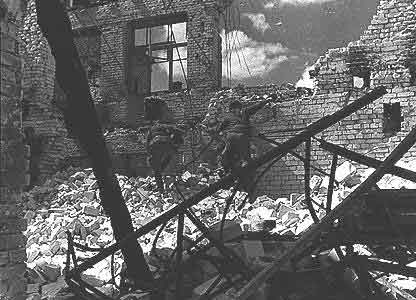
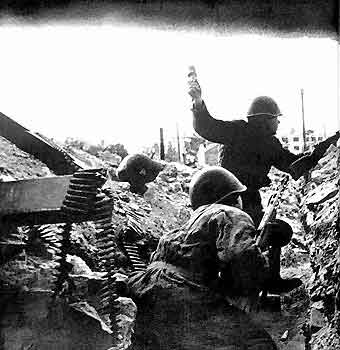
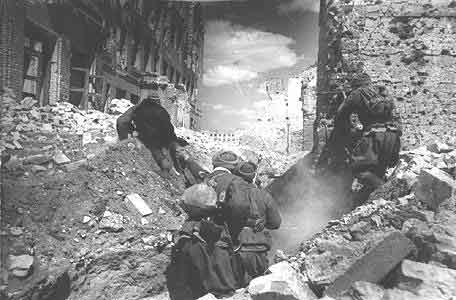
Sadly many brave men and women found their final resting place on the streets of Stalingrad, and had to give their lives for the greater cause, leaving behind their loved ones, and the joy of freedom for which they fought so courageously, and desperately, to future generations...
Web site made by Igor Radisic from Belgrade, Serbia & Montenegro. E-mail: [email protected]
60 years later... D-day | Blue grave... Pearl Harbor | A bridge too far... Operation Marketgarden | Dust in the wind... El Alamein | Horrific thunder... Kursk
© Copyright protected. All rights reserved. Igor Radisic 2004 - 2005